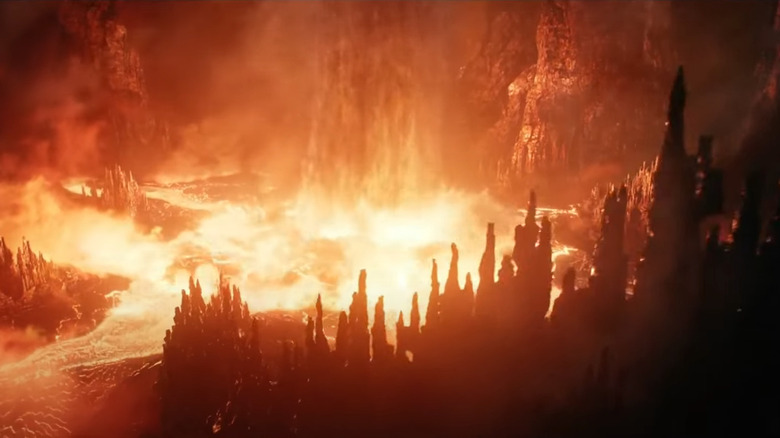The Rings Of Power Episode 6's Mount Doom Explosion Is More Scientifically Accurate Than You Think
"The Rings of Power" Episode 6 had an explosive ending — quite literally. Following a massive battle between the Southlanders and Adar's Uruks, the former group have a mere moment of respite before they become aware of the true danger threatening them. Through a surprising series of events, the volcano that avid fans of JRR Tolkien's Middle-Earth mythos will recognize as Mount Doom erupts, raining red-hot chaos across the surrounding lands. As a result, the fate of many major characters is thrown into question and the ravaged region of the Southlands takes its first step into becoming Mordor, the fiery hellscape where Sauron takes residence during "The Lord of the Rings."
While it's really cool that "The Rings of Power" Episode 6 showed us the creation of a Middle-earth landmark, one of the most interesting things about this new origin story for Mordor isn't necessarily why it happens, but how it happens. Considering the fantasy setting, one might expect the realm to be created with some sort of mystical spell, but that actually couldn't be further from the truth. As it turns out, the chain of events which leads to Mount Doom's volcanic reaction may be one of the most scientifically-accurate sequences across any piece of Middle-earth media yet.
The Mount Doom explosion passes scientific scrutiny
Rather than magic, the explosion of Mount Doom occurs due to a chemical reaction — the same as any ordinary volcanic event. Unlocked by a key, a massive rush of water spreads through the Orcs' underground tunnel system, eventually flowing into the heart of Mount Doom and mixing with superhot magma, causing it to erupt.
Jeffrey Karson, a professor of Earth and Environmental Sciences at Syracuse University, confirmed to The Hollywood Reporter that the depiction is mostly accurate. "Violent volcanic eruptions occur in large part because water is involved," he explained. "The water is dissolved in the magma. The magma rises to the surfaces, the water makes bubbles that can turn to steam and the steam and water expand so rapidly that they basically blow the magma apart."
This depiction of Mordor's formation was a conscious choice from series showrunners J.D. Payne and Patrick McKay. "A huge theme in Tolkien is the environmentalism and the way machines and industrializations destroys the land," McKay told The Hollywood Reporter. "We wanted that to be central and core all the time."
Injecting arguably the most iconic Middle-earth locations' backstory with a surprising dose of reality is bold and may prove to be another instance of "The Rings of Power" upsetting Tolkien purists, but it's simply part of the creative team's greater vision. "It was an incredible opportunity to show a side of Middle Earth that people haven't seen on screen before," executive producer Lindsay Weber told InsideHook.

